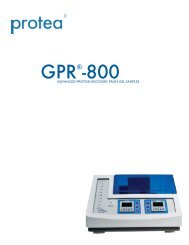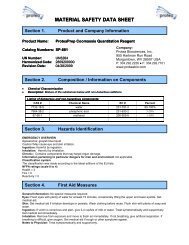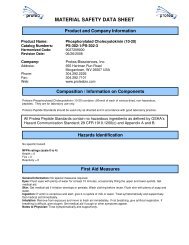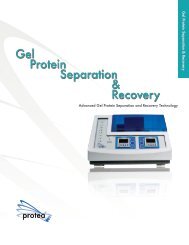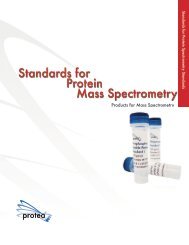Analysis of Hydrophobic and Hydrophilic Silica TLC Plates ... - dichrom
Analysis of Hydrophobic and Hydrophilic Silica TLC Plates ... - dichrom
Analysis of Hydrophobic and Hydrophilic Silica TLC Plates ... - dichrom
You also want an ePaper? Increase the reach of your titles
YUMPU automatically turns print PDFs into web optimized ePapers that Google loves.
Results<br />
To illustrate the capability <strong>of</strong> LAESI for imaging compounds<br />
separated on <strong>TLC</strong> plates, two plate types, a hydrophobic <strong>and</strong><br />
hydrophilic <strong>TLC</strong> plate were used for LAESI-MS analysis.<br />
Compounds 1 <strong>and</strong> 2 were separated on the hydrophilic <strong>TLC</strong><br />
plate as shown in the schematic <strong>and</strong> fluorescence optical<br />
image in Figure 1A.<br />
[des-‐Arg]-‐Bradykinin<br />
Substance P<br />
m/z = 452.7<br />
m/z = 674.9<br />
A)<br />
245.12 471.16<br />
100<br />
1<br />
100<br />
555.09<br />
2<br />
ACTH (7-‐38)<br />
m/z = 1220<br />
B)<br />
Relative Abundance<br />
1687.96<br />
Relative Abundance<br />
245.06<br />
1085.97<br />
Figure 2: Ion maps <strong>of</strong> peptides (substance P, [des-Arg]-Bradykinin<br />
<strong>and</strong> ACTH (7-38)) separated on a C18 reversed phase silica bead<br />
plate.<br />
C)<br />
0<br />
200 600 1000 1400 1800<br />
m/z<br />
0<br />
200 600 1000 1400 1800<br />
m/z<br />
Conclusion<br />
The Protea LAESI DP-1000 system can be used to analyze<br />
compounds separated on both hydrophilic <strong>and</strong> hydrophobic<br />
<strong>TLC</strong> silica plates, by simply wetting the <strong>TLC</strong> plates with<br />
water. This analytical method can be used to determine both<br />
the location <strong>and</strong> confirm the identity <strong>of</strong> analytes separated on<br />
<strong>TLC</strong> plates.<br />
Figure 1: A) Schematic <strong>of</strong> the separation scheme <strong>of</strong> the two<br />
compounds, <strong>and</strong> a fluorescence optical image <strong>of</strong> separated<br />
compounds 1 <strong>and</strong> 2. B) Resulting mass spectra from LAESI-MS<br />
analysis. C) Ion maps <strong>of</strong> the compounds from ProteaPlot s<strong>of</strong>tware<br />
overlaid on <strong>TLC</strong> images <strong>of</strong> the analyzed <strong>TLC</strong> plate. The<br />
approximate position <strong>of</strong> the compounds optically visualized on the<br />
plate matched the position <strong>of</strong> the compounds indicated by the ion<br />
maps from LAESI-MS analysis.<br />
After performing LAESI-MS analysis on these plates, the<br />
data files were analyzed using ProteaPlot imaging s<strong>of</strong>tware<br />
to determine the location <strong>of</strong> the separated compounds<br />
shown in Figure 1B (sodium adducts at m/z 471.2 <strong>and</strong> m/z<br />
555.1). By overlaying an optical image <strong>of</strong> the <strong>TLC</strong> plate <strong>and</strong><br />
the ion map <strong>of</strong> the compounds from ProteaPlot s<strong>of</strong>tware<br />
(Figure 1C), very good correlation was achieved between<br />
the location <strong>of</strong> the compounds from ProteaPlot ion maps,<br />
<strong>and</strong> the locations indicated by optical fluorescence<br />
visualization (pencil circles). Similarly, an ion map from the<br />
separation <strong>of</strong> peptides on a hydrophobic <strong>TLC</strong> plate was<br />
achieved (Figure 2), showing the locations <strong>of</strong> three<br />
separated peptides, Bradykinin (m/z 452.7), Substance P<br />
(m/z 674.9) <strong>and</strong> ACTH (7-11) (m/z 1220).<br />
References<br />
(1) Han, Y, P. Levkin, I. Abarientos, H. Liu, F. Svec, <strong>and</strong><br />
J.M.J. Fréchet. Monolithic superhydrophobic polymer layer<br />
with photopatterened virtual channel for the separation <strong>of</strong><br />
peptides using two-dimensional thin layer chromatographydesorption<br />
electrospray ionization mass spectrometry.<br />
Analytical Chemistry. 2010, 82, 2520-2528.<br />
(2) Fuchs, B. R. Süß, A. Nimptsch, J. Schiller. MALDI-TOF-<br />
MS directly combined with <strong>TLC</strong>: a review <strong>of</strong> the current state.<br />
Chromatographia Supplement. 2009, 69(1), 95-105.<br />
(3) Robards, K., P.R. Haddad, P.E. Jackson. Principles <strong>and</strong><br />
practice <strong>of</strong> modern chromatographic methods (pp. 44, 182-<br />
224). 1994. San Diego, California: Academic Press.<br />
(4) Van Berkel, G.J., M.J. Ford, <strong>and</strong> M.A. Deibel. Thin-layer<br />
chromatography <strong>and</strong> mass spectrometry coupled using<br />
desorption electrospray ionization. Analytical Chemistry.<br />
2005, 77 (5), 1207-1215.<br />
(5) Nemes, P. <strong>and</strong> A. Vertes. Laser ablation electrospray<br />
ionization for atmospheric pressure, in vivo, <strong>and</strong> imaging<br />
mass spectrometry. Analytical Chemistry. 2007, 79, 8098-<br />
8106.<br />
Acknowledgements<br />
We acknowledge Dr. Miaosheng Li for preparing the<br />
hydrophilic <strong>TLC</strong> plates for analysis.<br />
© 2011 Protea Biosciences, Inc • 877.776.8321 • www.proteabio.com 2



